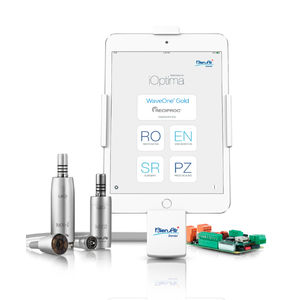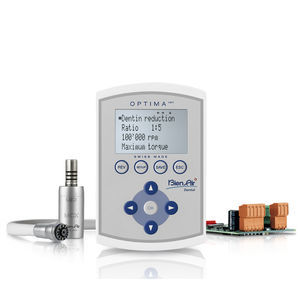
- Dental
- Dental instrument
- Dental micromotor
- Bien-Air Dental
Dental micromotor MC2electricwith LED light

Add to favorites
Compare this product
fo_shop_gate_exact_title
Characteristics
- Applications
- dental
- Operation
- electric
- Lighting technology
- with LED light
- Speed
Min.: 60 rpm
(377 rad.min-1)Max.: 40,000 rpm
(251,327.4 rad.min-1)- Sound level
54 dB
Description
The MC2 is the most widely used electric micromotor in the world. Prized and recommended for its reliability and endurance, it has been proving its worth for many years. With a rotation speed , the performance it offers is remarkable.
The MC2 micromotor: Swiss-Made design at an attractive price. Also available in MicroSeries version with short nose and LED light with adjustable intensity. Now also available as an upgrade set for your old MC2 Isolite 300.
All electric micromotors are made up of a rotor and a stator. The rotation is generated by magnets interacting with an electric current flowing through a wire coil. In the case of brush micromotors, the coils are located on the rotor. Electrical power is supplied to the coils through carbon brushes located on the stator. The electrical current in the coil interacts with the magnets of the stator, thus generating rotation.
Complex mechanical design (rotor: multiple windings, collector and brushes, stator: permanent magnet). The brushes wear out so they must be regularly replaced (approximately 18-24 months in a dental micromotor). The carbon dust from the brushes disperses in the micromotor and can reduce the life of the micromotor bearings. The carbon brushes can cause interference with other electronic devices because of their constant interaction with the electrical components in the micromotor. The carbon brushes cannot be washed or sterilized as they absorb moisture generated from an air compressor.
Bien-Air’s new generation Micro-Series models ally innovation with compact design, resulting in improved power and maneuverability.
VIDEO
Catalogs
No catalogs are available for this product.
See all of Bien-Air Dental‘s catalogsRelated Searches
- Drill
- Micromotor
- Contra-angle handpiece
- Turbine
- Dental turbine
- Air-driven turbine
- Dental contra-angle handpiece
- Electric micromotor
- Dental micromotor
- Dental handpiece
- Air contra-angle handpiece
- Autoclavable contra-angle handpiece
- Autoclavable turbine
- Micromotor control unit
- Electric drill
- Electric micromotor control unit
- Dental micromotor control unit
- Straight handpiece
- Autoclavable handpiece
- Reduction contra-angle handpiece
*Prices are pre-tax. They exclude delivery charges and customs duties and do not include additional charges for installation or activation options. Prices are indicative only and may vary by country, with changes to the cost of raw materials and exchange rates.










